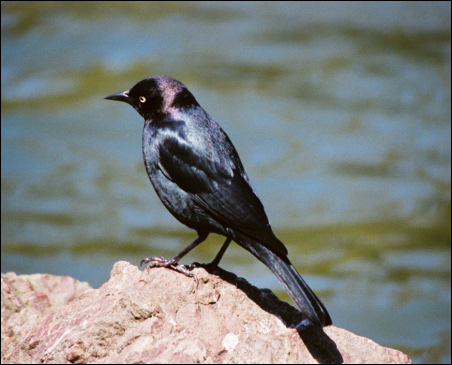
|
Context Kingdom: Animalia |
 |
Brewer's Blackbird (Euphagus cyanocephalus). Photograph by Lee Karney, courtesy of the U.S. Fish and Wildlife Service. |
About 8-10 inches (25-30 cm) long. The male of Brewer’s Blackbird is black with purple iridescence on the head and neck and a greenish gloss on the remainder of the body and wings; the eyes are yellow and there is a pale supercilium. the bill is blackish and sharp and pointed. Females are relatively drab, usually being brown or greyish-brown. However, the head and neck show a light purplish gloss and the body is metallic greenish with darker and glossier wings and tail; the eyes are brown and the supercilium dark. Juveniles are similar to females except paler and lack the gloss. At hatching, chicks are covered with sparse pale grey down feathers (Ran, 1981).
Euphagus cyanocephalus tends to inhabit open areas, espacially in the central Great Plains and throughout most of the western states (Tveten, 1993).
The species breeds from southwestern Canada east to Ontario and southward in the west to Mexico and in the Midwest to northern Illinois. It winters from southern British Columbia southward into southern Mexico and eastward through the southern United States to western Florida (Collin, 1996).
Feeding is primarily on invertebrates, including arthropods, spiders, insects, snails, and crustaceans. Other foods include seeds, grains, berries, nectar, and small vertebrates. Chicks are fed a diet that includes 90% insects (Collins, 1996).
Nesting sites vary from placement on the ground to fixed in shrubs or trees. Females build the nest, constructing an open cup of twigs and grasses and other vegetation mixed with mud and cow dung. The cup has a lining of rootlets and hair. The clutch consits of 3 to 7 pale grey or greenish, brown-speckled eggs. Incubation by the female lasts some 12 to 14 days; the male protects her and the nest site, occasionally feeding her. Chicks are altricial, having to be fed by both parents. The nest is abandoned some 13 to 14 days after hatching. Although usually only one clutch is laid, occasionally a second is produced (Collins, 1996).
Brewer's Blackbird tends to be comfortable around humans. The common name is after the prominent ornithologist, Thomas Mayo Brewer (Tveten, 1993). Foraging often is in mixed flocks of other blackbirds. Although primaily a ground forager, it may wade into shallow water to feed on aquatic insects or catch insects while hovering over water. Nesting is in compact colonies varying in size from a few pairs to over 100. In the colony, a female, sometimes with a male, defends and protects an area around the nest site. Brewer's Blackbird may sometimes practice polygamy, when surplus of females are available. They gather in spring after spending the winter season separately, in migrating flocks. while Brewer's Blackbird walks on the ground, it bobs its head forward in a short and jerky motion. Male performs an elaborate display during breeding season, including fluffing out feathers, spread wings and tail, cocking tail and pointing bill upward (Collins, 1996).
Collin, D. 1996. Oiseaux website. Accessed on 1 March 2006. .
Ran, J. E. 1981. Harper and Row's complete field guide to North American wildlife. Harper and Row Press, New York.
Tveten, J. L. 1993. The Birds of Texas. Shearer Publishing, Fredricksburg, TX.

Angelique Anaya, February 2006.